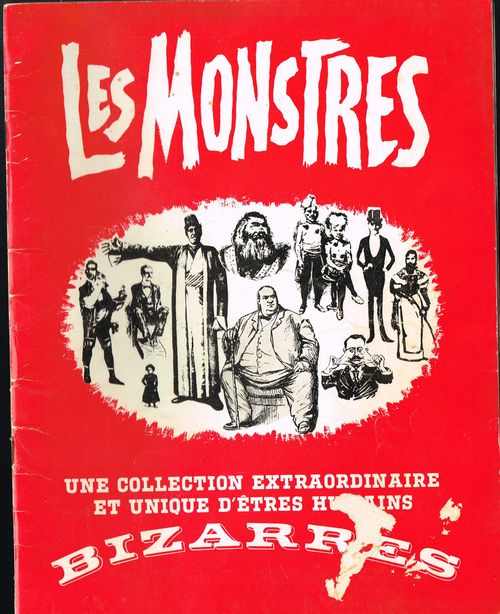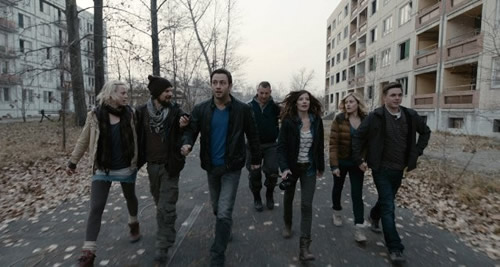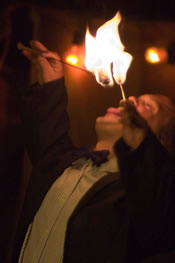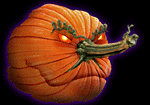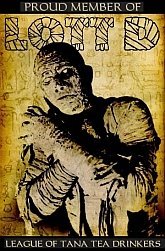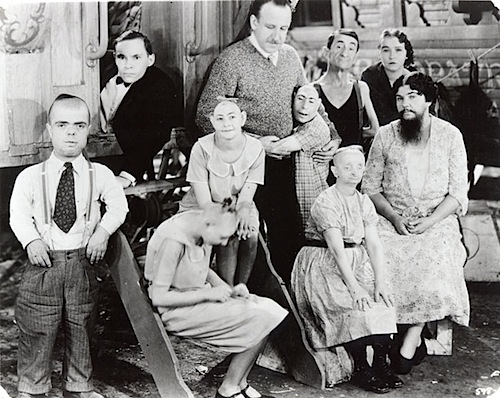
Zombos Says: Classic
A peal of thunder echoed outside,
followed by a flash of lightning. Rivulets of water started sliding down the
narrow windowpanes of the library; a perfect setting in which to view one of
cinema’s more outré movies, Freaks.
Zombos passed the bottle of claret over to Uncle LaVey, the blackest of the
black sheep in Zimba’s family tree, and I inserted the DVD into the player.
Dressed in his black shirt and pants, and with his black widow’s peaked
hairline and black goatee, he presented quite the look of the Satanist about
town.
As we watched the movie I could not
help but wonder what Tod Browning and MGM were thinking when they made this
movie? Browning definitely wanted to shock and unsettle his audience, and MGM
wanted a horror movie that would rival his earlier Dracula success; but
what both eventually achieved was an exploitation styled B-movie with flashes
of brilliance and disgust that has entertained, insulted, and outraged
audiences since 1932. The story of little Hans (Harry Earles) and his futile
infatuation with the considerably taller Cleopatra (Olga Baclanova), set
against the backdrop of the sideshow and its singular denizens, still manages
to make one ill at ease upon viewing.
No other movie has embraced the
participation of real-life freaks like Browning’s film does here: Prince
Randian, the Living Torso; Pete Robinson, the Living Skeleton; Olga Roderick,
the Bearded Lady; Martha Morris, the Armless Wonder; Joseph/Josephine, the
Half-Man, Half-Woman; the Pinheads; the Hilton Sisters; Johnny Eck, The
Half-Boy; Angelo Rossitto (Master in Mad Max Beyond Thunderdome) and the
others were well off the bell curve average. While Browning was heading down a
less traveled cinematic road with movies like
The Unholy Three and The Unknown, his need for showing the
unconventional hit its zenith in Freaks.
Taking Tod Robbins’ story Spurs,
Browning (who had already used Robbins’ novel The Unholy Three with
critical and financial success), weaves a tale of murder and revenge that’s
more unsettling and ends more horrifically than its source material. Adding a
sexual overtone that undoubtedly offended his ‘normal’ audiences when it first
hit theaters, and portraying his actors as regular people with incredible
physical characteristics, then unleashing them as demonic angels of vengeance
when mistreated, Browning makes you squirm and sweat watching it all unfold.
“Gooble, gobble!” LaVey chanted as
the infamous wedding feast scene began. “Zombos, this scene always reminds me
of your wedding,” he joked. Zombos was not amused.
Come to think of it, it reminded me
of his wedding party, too. How odd.
The wedding scene is the highlight
of the movie. It is here Cleopatra humiliates Hans and his friends, thereby
sealing her doom. Falling back on his more comfortable silent movie direction
skills, Browning even introduces the scene with an intertitle card announcing “The
Wedding Feast.” While he may be comfortable, we aren’t as unsettling close-ups
of the circus friends enjoying the festivities are juxtaposed with Hans’
growing realization he’s made a mistake. The drunk Cleopatra openly shows her
affection for Hercules, the sideshow’s strongman. As Hans sits, humiliated, the
oblivious revelers begin chanting “gooble, gobble, gooble, gobble, we accept
her, we accept her one of us.” While the chant continues, Angelo Rossitto jumps
on the table and passes around a large goblet overflowing with wine so everyone
can take a sip from it. Cleopatra looks in horror as the cup comes closer and
closer, eventually recoiling in terror as the cup is held up to her. She takes
it and yells “No…dirty…slimy freaks!” and tosses the wine into Rossitto’s
startled face.
In his book, The Monster Show,
David Skal notes the wedding feast was heavily censored, and one particularly
interesting element that would have intensified and justified Cleopatra’s
horror at drinking from the communal goblet was removed; as the cup is being
passed around, some freaks dribble into it. I leave it to you whether this possibly
more nauseating visual should have been included.
Foreshadowing the horror to come,
Browning uses more close-ups of Rossitto’s scowling face furtively peering into
Hans’ wagon, watching Cleopatra slowly poisoning him, and again as he peers
into Hercules’ wagon to see her and the muscle man conspiring against Hans.
What follows is one of horror cinema’s more memorable series of scenes as Hans’
friends carry out their revenge.
As Tetrollini’s Traveling Circus
prepares to get under way during a dark and stormy night (well, it was), we see Johnny Eck scampering beneath the wagons. As
lightning and thunder play in the background, the camera follows him making his
way to the huddled group of freaks patiently waiting, away from prying eyes,
for their moment of reckoning.
With the traveling circus underway
in the downpour, we cut to Hans’ wagon, rolling along in the muddy road. His
diminutive friends, gathered by his bedside, quietly watch as Cleopatra once
again prepares her poisonous medication. Only this time, Hans confronts her,
asking for the bottle of poison. She looks down at Hans, then in horror at his
friends who quietly pull out their knives to casually clean them. Cleopatra is
understandably alarmed and the spoon of poison drops from her numb fingers.
Now cut to mighty Hercules who is
also having a bad night. A knife flashes through the dark and slides into his
side, bringing him down to the muddy road, down to their level, where he is
relentlessly pursued by a swarm of freaks crawling through the mud and rain,
brandishing weapons. The scene is nightmarish. I wonder how much audiences in Browning’s
day squirmed in their seats watching it. The ending that was intended, but not
used, has Hercules survive, but speaking with a much higher voice. You can draw
your own conclusions.
Now back to Cleopatra: her wagon
overturns and she briefly escapes the little demons by running into the nearby
woods. We see her screaming one last time as they close in on her.
The original ending had a tree
struck by lightning fall on her, crushing her legs, and the freaks swarming
over her prostrate form to exact their hideous revenge. As shown in the final
movie, after her scream we immediately move ahead in time to a sideshow where
she appears horribly disfigured as one of the freak attractions. Dressed in a
humiliating bird costume and unable to speak, she can only utter unintelligible
sounds. The once proud and beautifully statuesque Cleopatra is now a hideous
mute freak with a shattered mind and body.
As the movie ended, Zimba returned
to snatch Uncle LaVey away. Zombos and I breathed a sigh of relief. Returning
to our claret, we pondered the vagaries of moviemaking, and how a daring
director got a major studio to produce one of the oddest classics of horror
cinema. Forgotten for a very long time and almost lost to us, it was given new
life and much needed recognition in the 1960s by photographer Diane Arbus’ successful
efforts to bring it to the attention of the cinema art-house crowds.
So we can always remember that “But
for an accident at birth, you might be as they are.”

